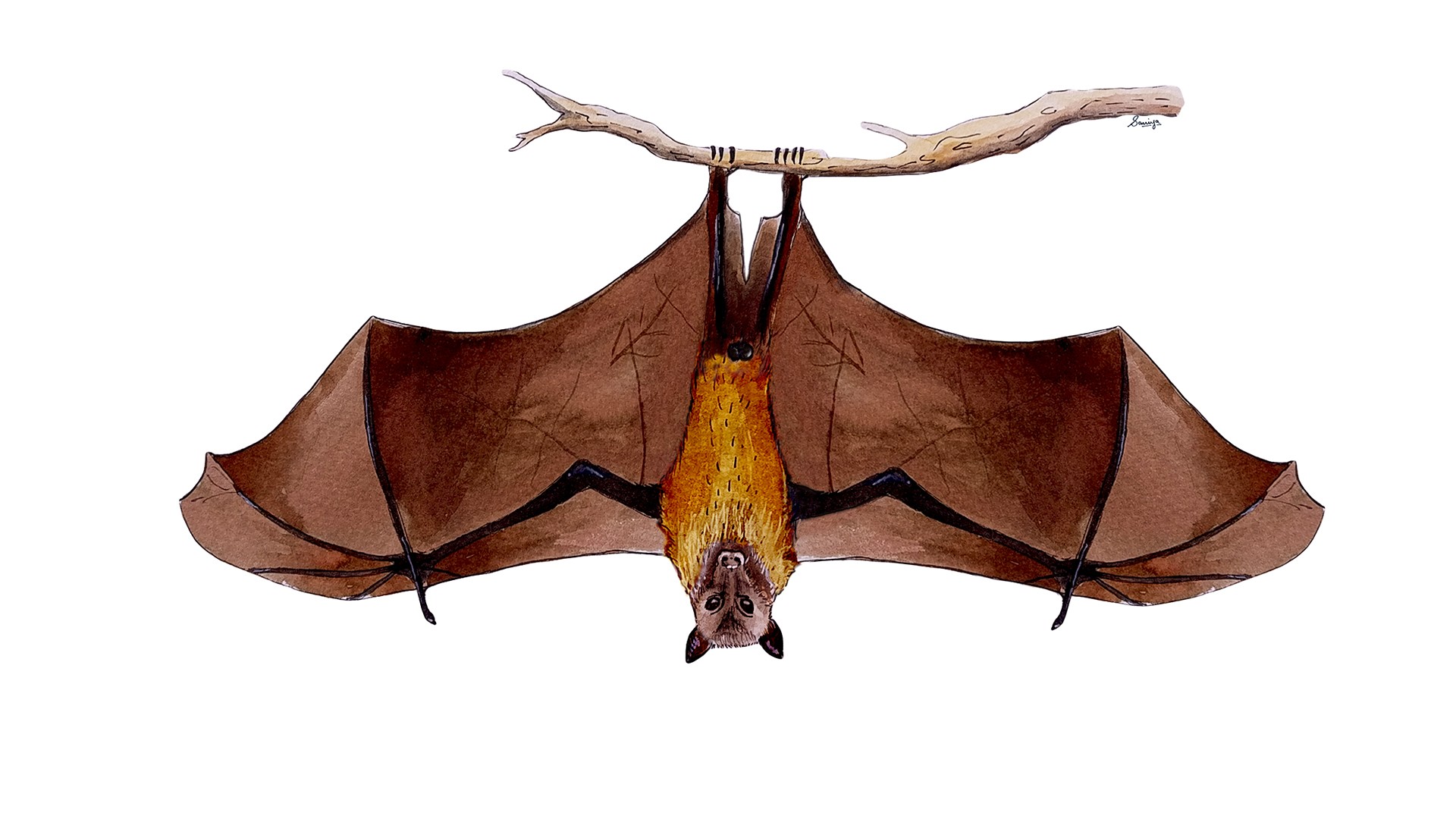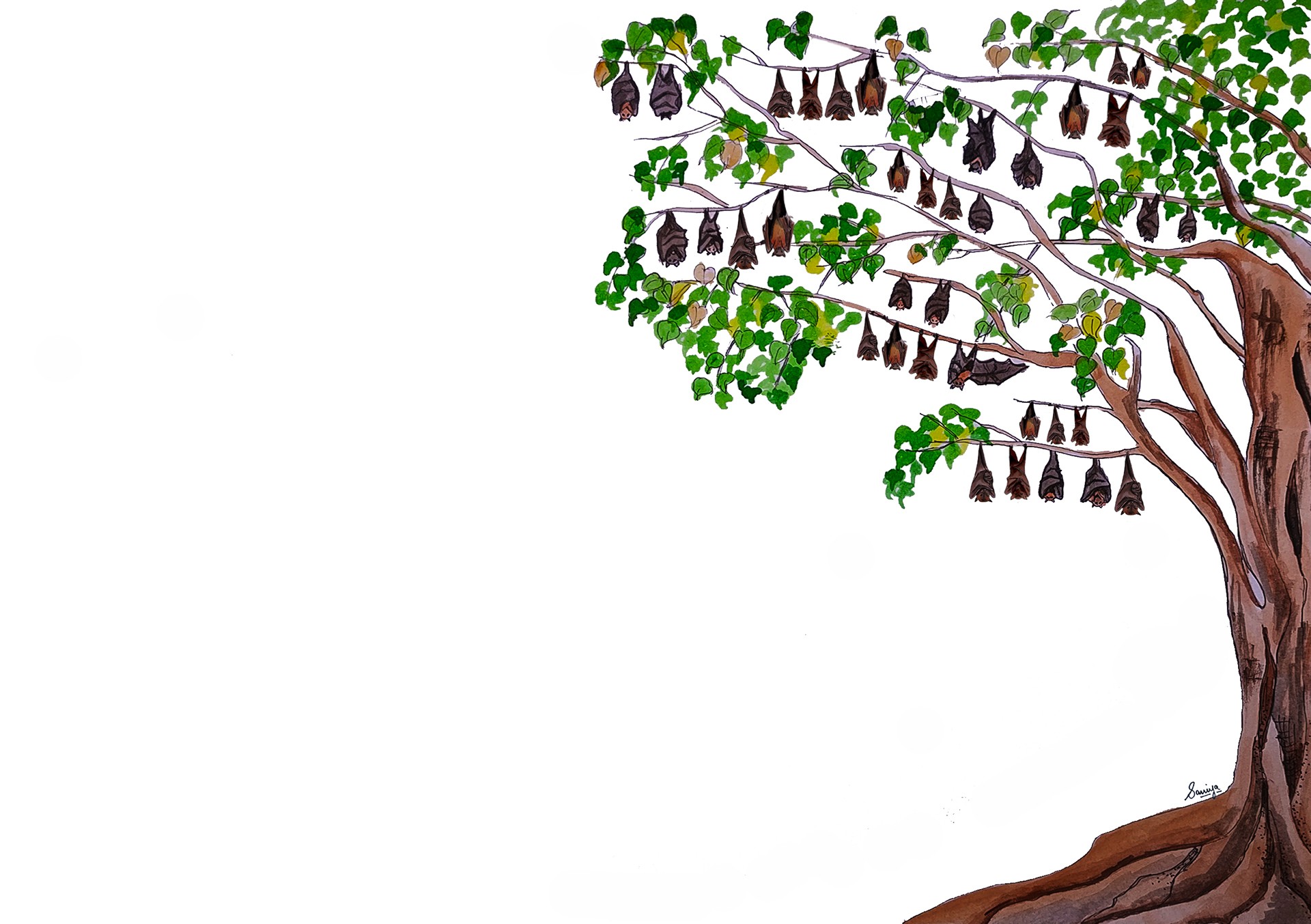Sure, there’s a wealth of flora and fauna to seek out in our sanctuaries, reserves and jungles. Wildlife enthusiasts will always be drawn to, well, wild spaces, but in the quiet time between each adventure, we should remember there’s a wide range of fascinating biodiversity to encounter in our cities, too. Through this new series, we encourage the Nature inFocus community to explore our urban biodiversity, to notice the often-overlooked flora and fauna in our midst, and to appreciate their fascinating ecology and behaviour. Each story will focus on a single species representing different taxa, and will be illustrated by a different artist. This is the fifth story in the series. Look out for the next installment, all about the grass Cynodon dactylon next month.
As dusk falls, the fading orange skies begin to be ruled by large winged mammals. Dotted with silent silhouettes of thousands of these gliding creatures, the evening skies come to life. These dark knights are Fruit Bats, also known as Indian Flying Foxes (Pteropus giganteus).
With chestnut-brown fur on their bodies, long snouts and large eyes, they bear a striking resemblance to foxes, and hence the name. These bats occur in South and Southeast Asia and in China. A contender for the world’s largest bat species, the Indian Flying Fox weighs up to 1.6kg and its wingspan extends to 1.5 metres.
Like all bats, Flying Foxes are mainly nocturnal i.e. they rest during the day and are active in the night. They live in colonies comprising of males, females and young ones. Every morning, these bats congregate in hundreds to thousands at a common resting site or ‘roost’. This site can be a stand-alone tree or multiple trees located close to water-bodies, along roads or near agriculture fields. In most cities, colonies of bats hanging upside-down are commonly encountered on large trees like the Banyan, Peepal, Tamarind and Rain Tree.
Each bat colony has a permanent roosting site but temporary sites may be used additionally in different seasons. Within the colony, dominant males occupy the best spots – treetops exposed to the sun when cold, or under dense branches during hot days or heavy rains.
These bats can be a noisy bunch. Though their flight is silent, and you will hardly hear the flapping of their wings, they may squabble, shriek and produce shrill squeaks while flying, feeding and perching.
These seemingly inane sounds, however, are important for communication between individuals. They vocalise to greet members of the same colony, ward off intruders and indicate the location of food sources. During the mating season, from July to October, female bats vocalise in the process of resisting advances of males trying to copulate them. Males on the other hand are vocal post-copulation, when they follow the females for a while.
Flying Foxes are unusual in one aspect. Though bats are famed for their use of bio-sonar technology to navigate, interestingly, Flying Foxes do not echolocate. Instead, they rely on good vision and their sense of smell for orientation and locating food sources. Further, these bats possess dichromatic colour (daylight) vision, commonly seen in other mammals but absent in echolocating bats. This type of vision is thought to facilitate navigation at dusk.
At dusk, Flying Foxes take off from the roost and travel long distances in search of food, sometimes as far as 100 kilometres. They feed on a wide range of flowers, leaves and fruits, both wild and cultivated. Figs (Ficus spp) make up a large proportion of their diet. Some individuals have been observed to spend as long as eight hours at a stretch on a single Ficus tree at its peak fruiting. These Fruit Bats are also known to devour commercially important fruits such as Betel nut, Mango, Guava, Papaya and Banana. In lean times, when fruits aren’t as readily available, they feed on the leaves of trees like Peepal and the Indian Coral Tree.
Feeding may take place at the fruiting tree itself or by carrying fruits to more secure spots or the roosting site. It’s the fleshy part of the fruit that gets consumed. The other components like seeds get discarded while feeding or by excretion. This is turn helps in the dispersal of seeds over short as well as long distances. Bats are also prime pollinators of some nectar-producing plants that flower only at night (e.g. White Silk Cotton Tree, Banana).
As key agents of seed dispersal and pollination, Flying Foxes are thus vital for the regeneration of trees in forests and urban spaces. Additionally, their droppings, called guano, are considered a rich fertiliser and are collected in several regions.
Flying Foxes display an interesting behaviour to get drinking water. They skim the surface of water bodies with great skill and collect water droplets on their body fur. They then perch on a tree and lick this wet fur. These bats also engage in this belly-soaking behaviour in scorching summer months to keep themselves cool.
Flying Foxes harbour viruses like the deadly Nipah virus, which, when transmitted to humans leads to disease outbreaks. In 2008 in Bangladesh, consumption of Date Palm (Phoenix sylvestris) sap contaminated by P. giganteus led to cases of Nipah virus infection. The clay pots set up on the Palm trees to collect the sap were visited by these bats for food and served as sites for virus transfer.
Fruit Bats are sometimes hunted and killed because of the damage they cause to commercial orchards, and are often treated as vermin in India. They are sometimes killed for medicine or meat too. In some folk healing practices across the country, eating bat flesh has been prescribed as a cure for asthma. In addition, the indiscriminate cutting of trees for urbanisation has lead to loss of roosting and feeding habitats and thus declines in local Flying Fox populations.
Still, it is impossible to ignore the ecological services Flying Foxes provide. We hope the next time you look up at the evening sky and watch these enigmatic creatures glide by, you’ll be reminded of the valuable pollination and seed dispersal activities they will carry out in the darkness that follows. Many species in the plant kingdom really do depend on these flying mammals to flourish.
Last month, we wrote about the Golden Shower Tree. Read the story here.


